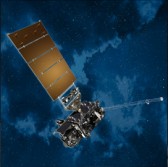 NASA has moved from Nov. 4 to Nov. 16 the launch of the first of the four National Oceanic and Atmospheric Administration’s geostationary weather satellites.
NASA has moved from Nov. 4 to Nov. 16 the launch of the first of the four National Oceanic and Atmospheric Administration’s geostationary weather satellites.
The space agency said Tuesday the Geostationary Operational Environmental Satellite-R system will be called GOES-16 once it reaches the geostationary orbit and will work to capture images of weather patterns every five minutes in order to help predict storms, monitor lightning conditions as well as generate aviation and maritime forecasts.
NOAA’s GOES-R satellite is originally scheduled to launch Friday from Cape Canaveral Air Force Station in Florida aboard a United Launch Alliance-built Atlas V rocket.
Lockheed Martin serves as the prime contractor for the design, development and testing of the GOES-R satellite, which will carry the Harris Corp.-built Advanced Baseline Imager as one of the payloads.




